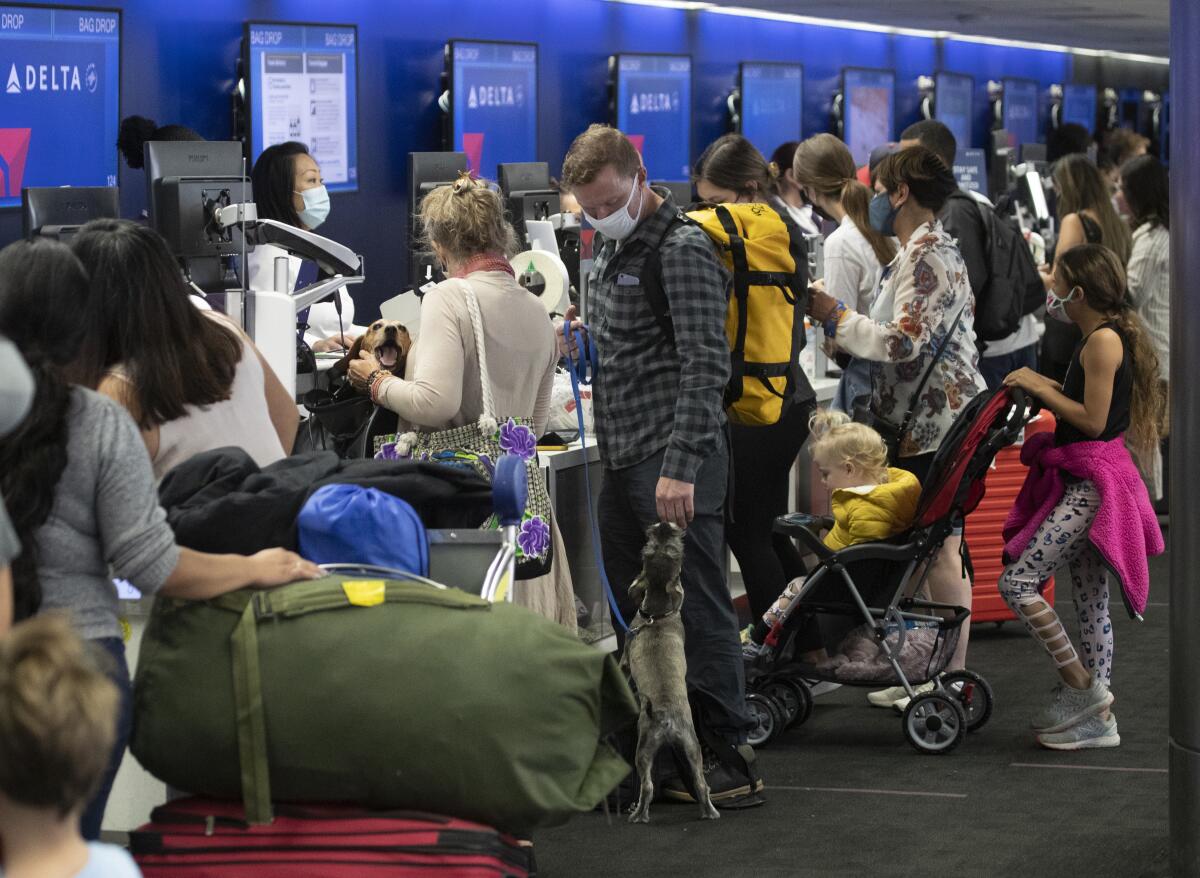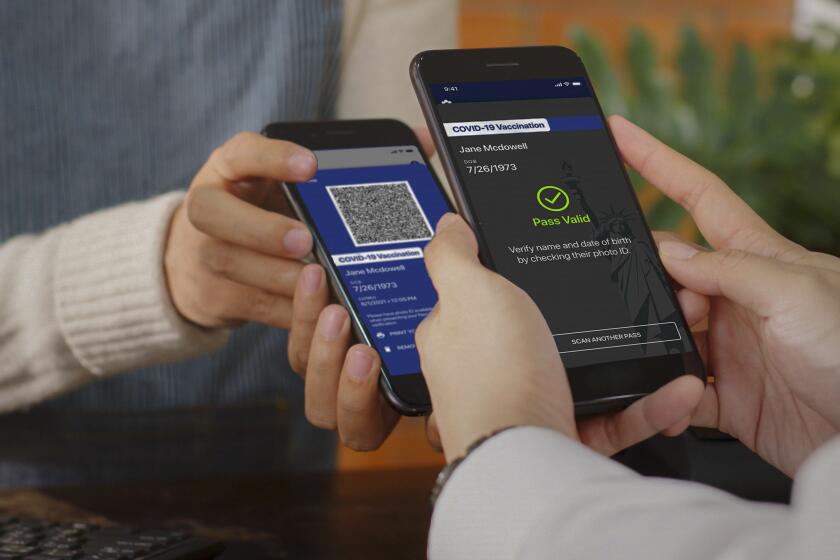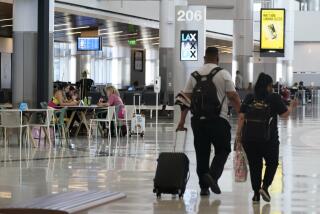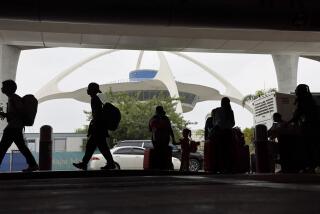Still planning summer travel? Here’s how to make it as painless as possible

- Share via
WASHINGTON — Passengers, airlines and government agencies are bracing for a last dash of summer air travel that probably will include more delayed flights and crowded planes.
In some ways, it feels like 2019 all over again — except it’s happening amid a jump in reports of unruly passengers and anxiety over the surging Delta variant of the coronavirus.
Here’s what you can expect as you prepare to take to the skies.
Crowded planes and airports
Thanks to COVID-19 restrictions that curtailed air travel, passengers last summer frequently had empty seats next to them and zipped through security checkpoints. That isn’t the case this year, as passengers have returned to airports, and planes to the skies.
The Transportation Security Administration reports that it is screening hundreds of thousands more passengers a day than in 2020. And on July 1 and 2 it screened more passengers than during corresponding days in 2019, the first time that has happened since the pandemic began.
Airlines are responding to the increased demand. The Fourth of July holiday week saw about 23,000 average daily domestic flights, according to FlightAware, an aviation tracking service. That’s down from the 30,000 average daily flights in 2019 — but way up from the 12,000 last year.
Since last summer, there has been a “continuing slow increase in domestic air travel volume to numbers that are still roughly 30% below what they were in 2019,” said Robert Mann, an aviation industry consultant. He added that during the summer, infrequent travelers “dominate the travel scene” as families with children take vacations, a trend that usually wanes as the school year begins in September.
Mike Boyd, another aviation consultant, said he believes August will be a “very strong month” in terms of air travel.
“We don’t know after Labor Day what’s going to happen, and I think our forecast is we’re going to see a drop in increase in demand,” he said. “I think it’s still going to go up, but it’s going to be a much lower increase.”
The federal government isn’t willing to make a digital pass or app that attests to a person’s vaccination status. Several companies are trying to fill the void.
Plan ahead, anticipate delays
Travelers are confronting the same kinds of flight delays typical of every summer. Data compiled by FlightAware show that 25% of flights were at least 15 minutes late from June 1 through Sunday. According to federal data, that is just about how airlines performed in June and July of 2019, and a bit worse than last year. May was a much better month to travel — only 14% of flights were canceled, up from 11% from 2020.
Flights out of Los Angeles International Airport departed late more than 20% of the time (with 155 cancellations) in June, according to data supplied by Cirium, another aviation data company. That was better than the 25% of flights leaving late in June 2019, but much worse than in June 2020 — 95% of flights that month left the gate on time.
Jim Hetzel, an air operations expert at Cirium, said that COVID-19 improved flight performance because there were far fewer flights, meaning less congested airways. As air travel has picked up, delays are closing the gap with 2019.
“We [see] flight volumes starting to approach pre-pandemic levels across all US airports,” he wrote in an email. “For some, that’s a good sign — it means demand is coming back. At the same time, the reasons might be different now such as fewer trained staff, more demand than labor capacity, and not just the usual weather-related delays.”
Experts advise passengers to plan ahead in order to avoid delays at the airport. “You just got to get there a little bit earlier,” Boyd said.
Unruly passengers could be a problem
Airlines and federal regulators have reported a surge in reports of unruly passengers. Some have tried to open doors on flights. Others have argued and chafed at mask mandates. And some have even physically assaulted flight attendants and other passengers.
“The FAA has seen a disturbing increase in incidents where airline passengers have disrupted flights with threatening or violent behavior,” the nation’s aviation regulator said in a news release issued July 20.
The FAA has received more than 3,500 reports of unruly passengers this year and has collected 2,605 reports of incidents involving passengers refusing to wear masks. It initiated more than 580 investigations of those incidents. In 87 of those cases, it has begun to take civil enforcement actions against the passenger. In 2019, the agency initiated a total of 146 such investigations. (It only started recently tracking unruly passenger and mask reports.)
Experts said they were not surprised to see such a surge in unruly behavior because anxiety is sky-high and many people resent wearing masks.
“It is really anxiety-inducing to come out of this, where a lot of us haven’t been around other people, to go from that to being in a crowded airport, to lots of people touching things, getting on a flight, being very cramped together,” said Dr. Rebecca Fielding-Miller, a social epidemiologist at UC San Diego. “That feels very scary and I don’t think that’s irrational. That’s a really normal response.”
Dr. Emanuel Maidenberg, a psychiatry and biobehavioral sciences professor at UCLA, said passengers’ personal beliefs may be inconsistent with mask-wearing, which fuels conflict if they are asked to wear a mask in a confined space.
Maidenberg added that excessive alcohol consumption — which has increased during the pandemic — has only worsened this tension. “It may well be that there is a larger percentage of people who end up being on the plane, who may have developed that habit of alcohol use, and therefore makes it more likely that something like that may happen.”
Leave your guns at home
The TSA has discovered more than 3,050 firearms in carry-on luggage at checkpoints (screeners at LAX have found 49) this year through July 22, according to an agency spokeswoman. At that rate, the TSA is on pace to find about 6,000 firearms by year’s end — up from the 4,432 firearms its screeners discovered in 2019, which was a record haul.
The number of detected firearms dropped to 3,257 in 2020, which was a record in per capita terms.
Those caught with guns at checkpoints “all say the same thing: ‘I forgot it was in my bag,’” said Keith Jeffries, the TSA federal security director for LAX. “A variety of events that have happened in our country led to a large purchase of firearms, so more and more people have firearms. And I’m not sure I can ever understand how someone can forget where they put it, but it does happen.”
Long-standing TSA policy mandates that firearms may only be transported in a locked, hard-sided container as checked baggage and must be declared as such during check-in. Firearms discovered by TSA screeners are turned over to police, who can file criminal charges if warranted.
Remember to relax
Despite rising anxieties surrounding air travel, veteran travelers and health professionals say it’s crucial to stay calm.
Dr. Neil Parikh, a 28-year-old general surgeon who was a frequent flier during the pandemic, arrived early for his flight Thursday from Washington’s Reagan National Airport to Los Angeles. He said he wasn’t concerned about reports of unruly passengers or delays. The key, he said, was to go with the flow. He reported upon landing that everything went smoothly.
“Some level of anxiety is understandable but it shouldn’t prevent people from flying, as long as they’re following all precautions and do get vaccinated,” Parikh said.
Maidenberg, the psychiatrist, said he hopes Americans will trust reputable sources of information when it comes to the safety of the vaccine and air travel, which he says will help quell their anxiety.
“It takes much longer to learn to not be afraid of something once we learn to be afraid of something,” he said.
More to Read
Inside the business of entertainment
The Wide Shot brings you news, analysis and insights on everything from streaming wars to production — and what it all means for the future.
You may occasionally receive promotional content from the Los Angeles Times.












